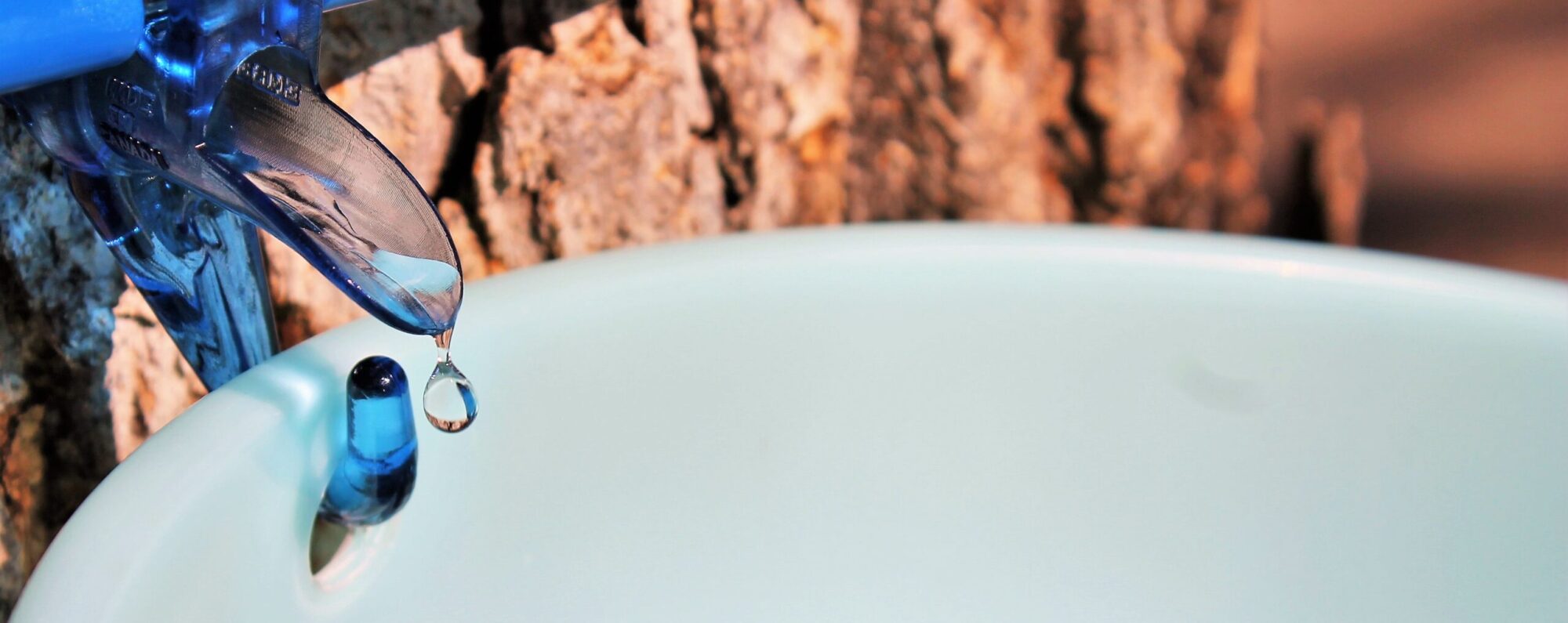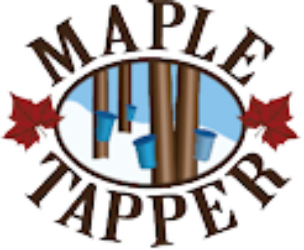Pure maple syrup is one of nature’s sweetest treats and making it yourself is much simpler than you think! All you need is a maple tree, regular kitchen tools which you most likely already have, and some patience. The process is not complicated and you can easily learn everything you need to know in one season. This short article walks you through the boiling process but be sure to click over to How to Tap Trees to learn about that step (we promise, quick and easy with minimal tools!).
Step One: Sugar Shack Preparation
The boiling process can take many hours, lots of fuel, and everything around the pots will be covered in a sticky film. Even the steam coming off the sap has tiny bits of sugar! For this reason, most sugarmakers boil their sap outside and many create a separate “sugar shack” to house their cooking and bottling operations. As a hobbyist, it’s not essential to build an entire sugar shack but you will need a cooker, some kind of overhead shelter with lighting, an abundant source of fuel such a split firewood or a large propane tank, and a work surface for bottling. You can find pre-made hobbyist evaporator pans from large suppliers as well as many DIY “evaporator plans” if you’d like to build your own cooking stove. Our book, Guide to Maple Tapping, also includes much more information on the tools needed for a well-functioning sugar shack.
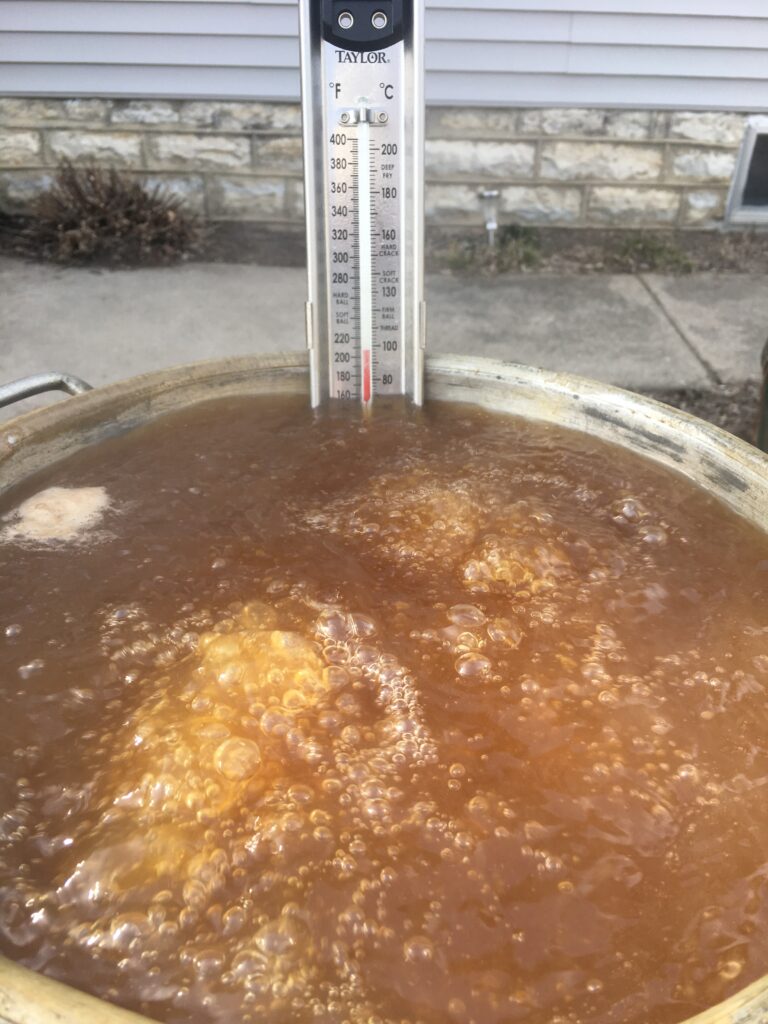
Step Two: First Filter
Sap is first filtered on the day it’s collected to remove debris or insects. Simply pour the sap through a piece of clean cotton cloth such as tee-shirt or a few layers of cheesecloth. Any materials used for filtering must not have been washed with detergent. The filtered sap is then either cooked immediately or chilled in a food-safe container until it’s time for boiling. Chilled sap will keep for up to five days but it’s best to cook it right away. Sap can also be frozen which might actually speed up the cooking process, click here for a short article on that.
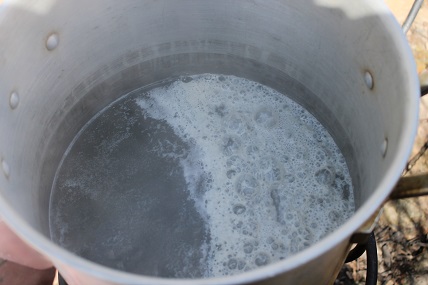
Step Three: Beginning Boil
Filtered sap is poured into a shallow evaporator pan and cooked over high heat. Because sap will sometimes boil over, 3- to 6-inches of space must be left at the top of the pan. This means that all the day’s sap may not fit into the evaporator pan at once. In this instance, the additional sap is warmed separately and added to the main batch as it boils down. This process is continued until all the sap is boiling in one big batch. Sap is boiled as aggressively as possible until the temperature reaches approximately 216°F.
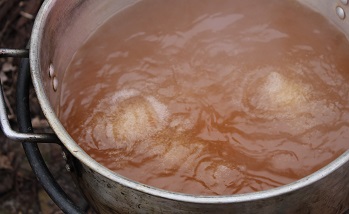
Step Four: Second Filter and Finish Boil
When sap reaches the 216°F range, remove it from the main heat source and filter through a thin prefilter designed for maple syrup making. This filtered sap is then boiled in a smaller pot on a cooker such as a regular kitchen stove or outside propane cooker. Watch carefully until the sap reaches 219°F (the temperature at which it becomes syrup).
Step Five: Final Filter and Bottling
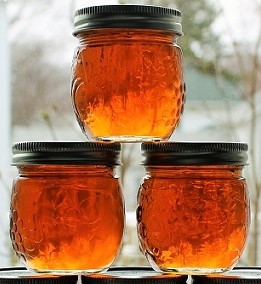
After it reaches 219°F, remove syrup from the heat and run through a two-layered filter to remove sugar sand or niter. The outside filter is a thick filter, the inside filter is the same type of thin filter used in step four. [If you’re using a hydrometer, now is the time to test your syrup — more on that below.] Suspend your filter over a large kettle (or into a clean coffee maker as shown here) and bottle syrup immediately. Try to avoid touching the rim but it’s also wise to wipe each rim with a hot, clean cloth before sealing. Seal bottles making sure to tip upside down so the hot liquid helps ensure a good seal (Make sure and use standard kitchen food safety guidelines.) Place jars sit on their sides for 24 hours, turning after the first 12 hours.
Using a hydrometer: most professional sugarmakers and those selling syrup use a hydrometer to test sugar content and grade the finished product. It is not an essential step but can improve the quality of your syrup.
Step Six: Storage
After the jars have cooled, they are wiped clean and stored away in a cool, dry place. Properly bottled and sealed pure maple syrup will keep for up to one year. Maple syrup can also be frozen indefinitely – it will not harden, though, due to the high sugar content. Once opened, syrup should be stored in the refrigerator and used within six months of opening. If you notice any mold or discoloration, discard the contents as it may not be safe to eat. Also, do not store your syrup in plastic containers as the syrup may absorb odd flavors or odors from the plastic.
A Few Common Questions
Why is my syrup cloudy or crystallized?
This sugar sand, or niter, is sometimes left if your syrup was not filtered enough. It can also be created by boiling the sap too far past the finishing point. In either case, it does not affect the quality of your syrup and will usually sink to the bottom during storage. You can reheat your syrup and put it through another filtering to remove the sugar sand.
What makes sap into syrup?
Sap becomes syrup as the water is removed through evaporation and the sugars become concentrated. The flavor of your finished syrup is created by the caramelization of the sugars during the boiling process – the longer the sap is boiled in the pan, the darker and stronger the flavors become. Flavor can also be affected by the tree’s qualities and genetics; by the time of year and method through which sap is collected; and by the cleanliness of the boiling room and storage containers.
How long does it take to boil down the sap?
The rate at which your water will evaporate depends on numerous factors such as: pan size and construction; type of heat source; and even the temperature of sap being added to the evaporator. If using a shallow, rectangular pan with lots of surface area, it takes between 9 and 18 hours to produce one gallon of syrup. With a deep, circular pan, it can take as little as 28 hours and as long as 56 hours.
Can I use maple syrup instead of sugar in my cooking?
It is a good substitute but will impart a maple flavor to your dish. Generally, one cup of pure maple syrup equals one cup of sugar and can be swapped out in most recipes. For cookies and cakes that also use liquid ingredients, just reduce the liquids by three tablespoons for each cup of maple syrup used.
What kind of trees can I tap?
Hard maples, also called sugar maple, black maple, or rock maple, have the highest sugar content and produce the best tasting syrup. You can also tap the red or silver maple but the sugar content is lower so you’ll have lower syrup yields and longer boil times. Folks also tap the box elder tree and the finished product has a heavy, sorghum-like flavor. Refer to an illustrated tree guide for identification tips or look in our book, Guide to Maple Tapping, for more information.
What parts of the country produce maple sap?
Because the sap “run” is triggered by the freeze-thaw cycle, maple syrup is only produced in the Upper Midwest, the Northeastern U.S., and Canada.
When should I tap trees?
The tapping season varies from region to region but generally starts in early March and lasts until mid-April. When the sap starts and stops running depends greatly on day and nighttime temperature fluctuations. Watch the weather forecast – sap starts flowing when the temperatures are below freezing at night but climb to the 40°F and above range during the day. If this freeze/thaw pattern is predicted, get out and tap your trees! Remove your taps when you have enough sap or when the tree buds out as that can lead to an off or “buddy” flavor in the finished syrup.
How much sap or syrup will I get from each taphole?
The amount of sap each taphole yields varies greatly depending on the tree, the time of year, environmental conditions such as the weather and soil conditions, and even at what point you are in the tapping season. In a normal season, a single taphole produces approximately 10- to 12-gallons of sap. Your finished yield of syrup will depend on the sugar content of your sap. Generally, assume a 40-to-1 conversion – so 12 gallons of sap will boil down to 1 quart of syrup. With this ratio in mind, you’d need four tapholes to produce one gallon of syrup for the season.
Does tapping hurt the tree?
If the tree is healthy when tapped and proper tapping procedures are followed, the taphole will start healing within weeks of the spile’s removal. Many maple tree farms have been tapping the same trees for over 100 years. Each taphole, however, must be placed in a different spot on the tree from the previous year. One thing to note: the bottom 4- to 6-foot “tapping zone” will result in trees that are less valuable if cut down for lumber.
